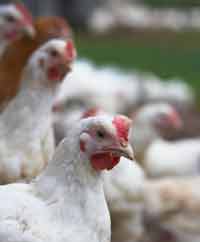More work needed on campylobacter in chicken

Results from a new survey of chicken on sale in the UK reveal that campylobacter was present in 65% of samples tested while only 0.5% tested positive for salmonella enteritidis and typhimuriun. The Foods Standards Agency carried out its second survey between May 2007 and September 2008 in an effort to better understand the prevalence of foodborne pathogens. Andrew Wadge, director of food safety at the Agency, said: “The continuing low levels of salmonella are encouraging, but it is disappointing that the levels of campylobacter remain high. It is obvious more needs to be done to get these levels down and we need to continue working with poultry producers and retailers to make this happen. “Other countries like New Zealand and Denmark have managed to do so, we need to emulate that progress in the UK.” Campylobacter is the most common bacterial cause of food poisoning. It is responsible for around 55,000 cases of illness in the UK every year, and is therefore one of the key organisms the Agency is tackling in order to reduce levels of foodborne illness. Campylobacter can be found on meat, unpasteurised milk, and untreated water; however there is strong evidence that chicken is the most common cause of illness. Reacting to the results, British Poultry Council chairman Ted Wright said: “We welcome the FSA survey which again confirms the very low prevalence of salmonella on chicken at retail sale. “However, the results for campylobacter really confirm that there is still much we do not know scientifically about this organism, not least the difficulty in measuring its presence or absence.” He went to criticise the FSA in changing the basis of the survey partway through, thus making results incomparable with the previous survey and with the previous prevalence estimate. “We need to concentrate on finding effective measures to prevent infection in flocks and less on targets that we cannot measure yet with confidence,” he said. NFU poultry board chairman Charles Bourns added: “The industry and the scientific community still have much to learn about campylobacter and what farmers can do in their businesses to reduce its presence at retail level. Results from a new survey of chicken on sale in the UK reveal that campylobacter was present in 65% of samples tested while only 0.5% tested positive for salmonella enteritidis and typhimuriun. The Foods Standards Agency carried out its second survey between May 2007 and September 2008 in an effort to better understand the prevalence of foodborne pathogens. Andrew Wadge, director of food safety at the Agency, said: “The continuing low levels of salmonella are encouraging, but it is disappointing that the levels of campylobacter remain high. It is obvious more needs to be done to get these levels down and we need to continue working with poultry producers and retailers to make this happen. “Other countries like New Zealand and Denmark have managed to do so, we need to emulate that progress in the UK.” Campylobacter is the most common bacterial cause of food poisoning. It is responsible for around 55,000 cases of illness in the UK every year, and is therefore one of the key organisms the Agency is tackling in order to reduce levels of foodborne illness. Campylobacter can be found on meat, unpasteurised milk, and untreated water; however there is strong evidence that chicken is the most common cause of illness. Reacting to the results, British Poultry Council chairman Ted Wright said: “We welcome the FSA survey which again confirms the very low prevalence of salmonella on chicken at retail sale. “However, the results for campylobacter really confirm that there is still much we do not know scientifically about this organism, not least the difficulty in measuring its presence or absence.” He went to criticise the FSA in changing the basis of the survey partway through, thus making results incomparable with the previous survey and with the previous prevalence estimate. “We need to concentrate on finding effective measures to prevent infection in flocks and less on targets that we cannot measure yet with confidence,” he said. NFU poultry board chairman Charles Bourns added: “The industry and the scientific community still have much to learn about campylobacter and what farmers can do in their businesses to reduce its presence at retail level.
